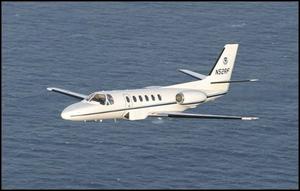Haiti disaster: Rescue technologyNOAA produces images of Haiti for first responders
The U.S. National Oceanic and Atmospheric Agency (NOAA) is using its geographic surveillance UAVs to help provide first responders on the ground in Haiti with high resolution images of disaster sites

Cessna Citation II // Source: www.aoc.noaa.gov
A specially equipped jet operated by the U.S. National Oceanic and Atmospheric Agency (NOAA)conducted aerial surveys of earthquake-stricken Haiti on 17 and 18 January as part of the agency’s effort to help responders assess damage and plan recovery efforts. The aircraft is equipped with high-resolution digital cameras and other sensors that collect data vital to disaster response, scientific research and environmental resource management efforts.
“NOAA maintains some of the nation’s premier emergency response services,” said Jane Lubchenco, under secretary of commerce for oceans and atmosphere and NOAA administrator. “We are proud to be of service in offering experts and expertise to help the people of Haiti during this heartbreaking time.”
Other facets of NOAA’s multi-tiered disaster response team are standing by, ready to conduct emergency maritime surveys and damage assessment imagery of key Haitian ports if requested. NOAA teams are often sent to ensure that waterways are safe for navigation and the transport of relief supplies. They also help assess chemical and oil spills and assist in recovery efforts.
Based at the NOAA Aircraft Operations Center in Tampa, Florida, the Cessna Citation II is a versatile twin-engine jet aircraft modified for acquiring remote sensing imagery, primarily in support of the NOAA National Geodetic Survey. The Citation is just part of NOAA’s fleet of aircraft and ships operated by the NOAA Office of Marine and Aviation Operations. The aircraft scheduled to replace the Citation, a King Air 350ER twin-engine turboprop, is being prepared for additional aerial surveys of Haiti.
NOAA provides this type of support in domestic emergencies, such as hurricanes and tsunamis. In international events, NOAA works closely with DHS, Department of Defense, Department of the Interior, and others to provide coordinated remote sensing response capabilities. NOAA has also partnered with Google and Environmental Systems Research Institute. Google produced a montage of NOAA’s imagery on Google Earth to make the images more publicly accessible.
The data is available to disaster responders and the public at: : http://hdds.usgs.gov/hdds/ and http://ngs.woc.noaa.gov/storms/haiti_eq/. Google Earth link provided by Google of the NOAA imagery: http://mw1.google.com/mw-earth-vectordb/haiti_noaa_jan17thv4/doc.kml
